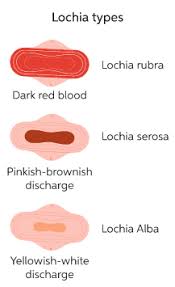 Lochia is the vaginal discharge after giving birth, containing blood, mucus, and uterine tissue.
Lochia is the vaginal discharge after giving birth, containing blood, mucus, and uterine tissue.
Lochia discharge typically continues for four to eight weeks after childbirth: the postpartum period or puerperium.
Lochia is sterile for the first two days, but by the third or fourth day the uterus begins to be colonized by vaginal commensals such as non-hemolytic streptococci and E. coli.
It progresses through three lochia stages:
Lochia rubra (or cruenta) is the first discharge, composed of blood, shreds of fetal membranes, decidua, vernix caseosa, lanugo and membranes.
The first stage of lochia is red in color because of the large amount of blood, and lasts 1 to 4 days after birth, before changing to to light spotting.
Lochia serosa refers to thinned discharge turned brownish or pink in color, containing serous exudate, erythrocytes, leukocytes, cervical mucus and microorganisms.
Lochia serosa stage continues until around the tenth day after delivery.
Lochia serosa which persists to some weeks after birth can indicate late postpartum hemorrhaging.
Lochia alba refers to lochia once that has become turned whitish or yellowish-white.
Lochia alba typically lasts from the second through the third to sixth weeks after delivery.
Lochia alba contains fewer red blood cells and is mainly made up of leukocytes, epithelial cells, cholesterol, fat, mucus and microorganisms.
In general, lochia has an odor similar to that of normal menstrual fluid.
The presence of an offensive odor or change to a greenish color indicates contamination by organisms such as chlamydia or staph saprophyticus.
Lochia that is retained within the uterus is known as lochiostasis or lochioschesis, and can result in lochiometra or distention of the uterus.
Lochiorrhea describes an excessive flow of lochia and can indicate infection.
